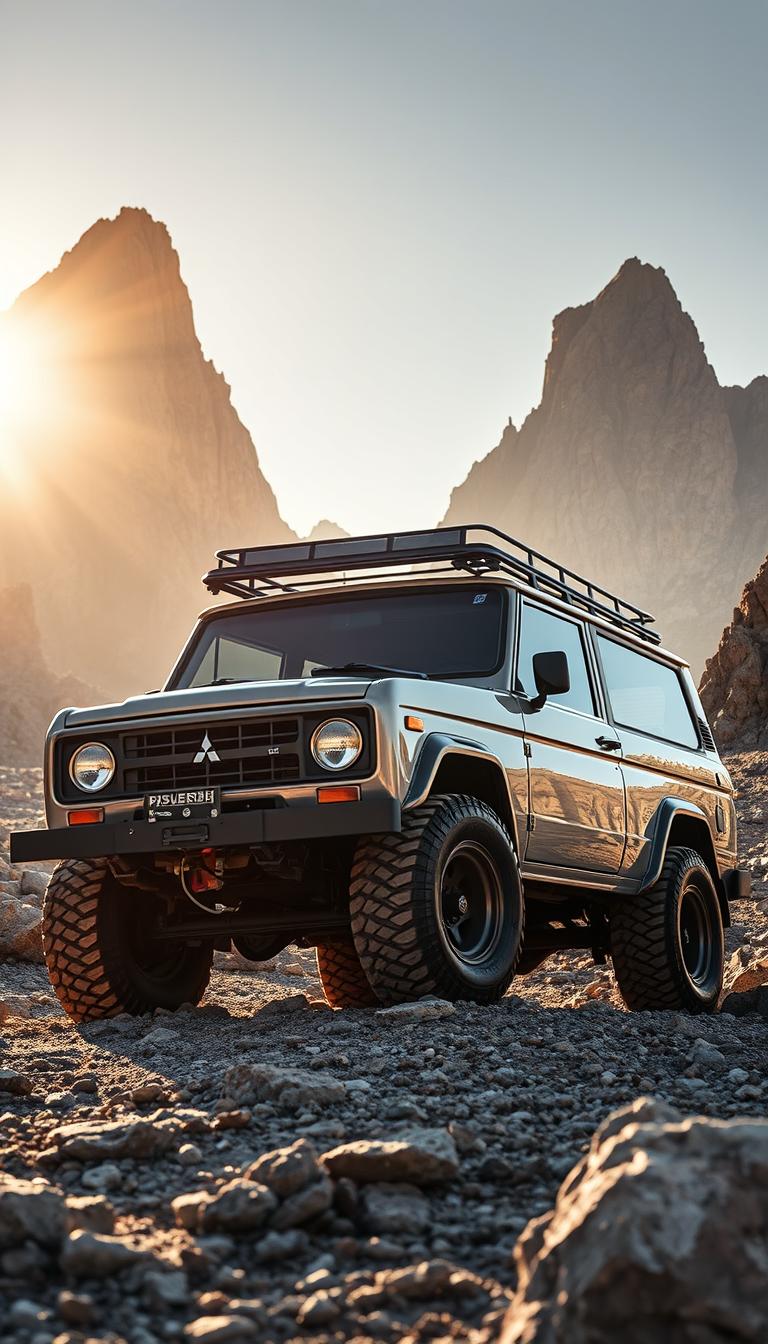Best classic Off-road Cars: Mitsubishi Pajero legacy
The Mitsubishi Pajero stands as a top classic off-road vehicle. It changed how people enjoyed car adventures for many years. This iconic SUV conquered many terrains around the world.
It was a true champion in exploring and lasting through tough conditions.
For four decades, this car changed what people wanted from an off-road vehicle. Its engineering and design made it famous worldwide. It was known as Montero in North America and Shogun in Europe.
This vehicle was more than a car. It was a symbol of freedom and adventure.
Key Takeaways
- 40-year production run showcasing exceptional engineering
- Global recognition across multiple international markets
- Pioneered advanced 4×4 technology in SUV segment
- Legendary performance in competitive off-road racing
- Versatile design adaptable to diverse terrains
The Birth of a Legend: Mitsubishi Pajero’s Origins
The Mitsubishi Pajero’s journey started long before its debut. It was rooted in Japanese automotive innovation. Your journey into this legendary off-road vehicle begins with its prehistory, linked to the Mitsubishi PX33 prototype from 1934.
The PX33 Prototype Development
Mitsubishi had a vision for an off-road vehicle in a time of great change in car design. The PX33 was a bold experiment that shaped the Pajero’s path. It featured:
- Advanced four-wheel-drive technology
- Robust chassis design
- Innovative suspension engineering
From Concept to Reality: 1973 Tokyo Motor Show
The 1973 Tokyo Motor Show was a turning point. Mitsubishi showed off the first Pajero prototype there. This event was a big deal, introducing a vehicle that changed the off-road market. The prototype stood out with its unique design.
| Prototype Features | Technical Specifications |
|---|---|
| Rugged Exterior Design | Advanced 4WD Drivetrain |
| Compact Body Structure | High Ground Clearance |
| Versatile Terrain Capabilities | Lightweight Chassis |
Market Introduction and Initial Reception
When Mitsubishi released the Pajero in 1982, car lovers saw it as a game-changer. The market welcomed this tough SUV, making it a rival to Land Rover and Toyota. Its mix of luxury and power set a new benchmark in off-road vehicles.
Evolution of the Pajero Name and Global Identity
The Mitsubishi Pajero’s name has a rich history across the globe. It was named after the Leopardus pajeros, a wild cat from South America. The vehicle became a global icon with unique names in different regions. Mitsubishi’s naming strategy showed they understood different markets well.
In Spanish-speaking countries and North America, it was called the Montero. This name means “mountain dweller” and fit its off-road skills well. In the UK, it was known as the Shogun, linking to Japanese warrior traditions and strength.
- Pajero: Original name derived from Pampas cat
- Montero: Used in Spanish-speaking regions
- Shogun: Branded in the United Kingdom
Mitsubishi’s naming strategy was more than just words. It showed their deep understanding of global markets. Each name was picked to match local tastes while keeping the SUV’s essence.
The Pajero’s global names made it famous worldwide. It went from a simple off-road car to a global legend. No matter the name, Pajero, Montero, or Shogun, it stayed true to its reliable and powerful nature.
First Generation Pajero (1982-1991): Pioneer of Innovation
The first generation Pajero changed the game in the 1980s with its off-road prowess. It redefined what rugged terrain vehicles could do. It set new standards for performance and versatility.
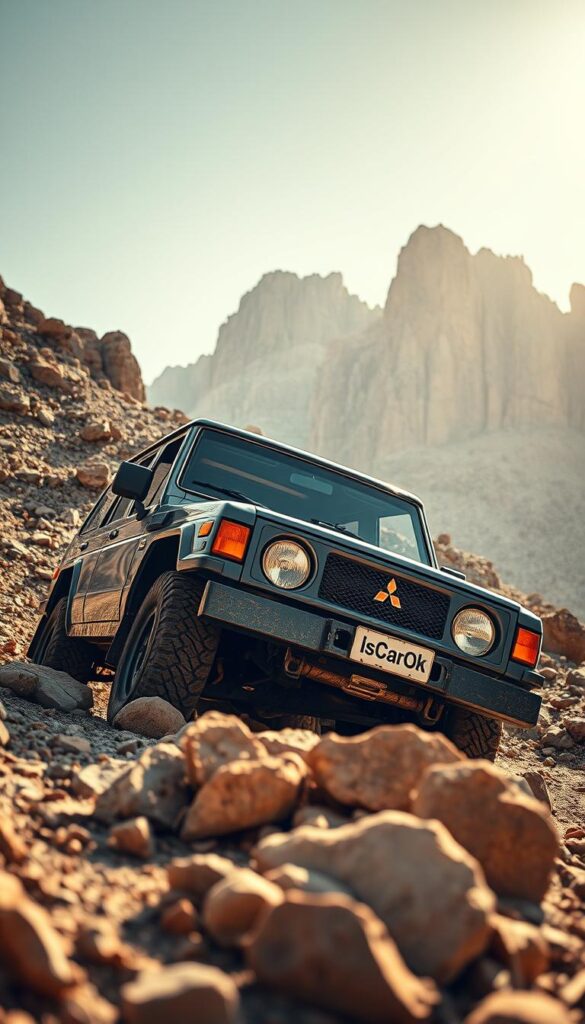
Revolutionary Design Features
Mitsubishi’s first generation Pajero had features that made it stand out. It came in short and long-wheelbase options to meet different needs.
- Robust body-on-frame construction
- High ground clearance for extreme terrain
- Lightweight yet durable chassis design
- Compact exterior with spacious interior
Engine Lineup and Performance
The Pajero engines were a big step up in power and efficiency. There were many options to choose from, balancing power with fuel economy.
| Engine Type | Displacement | Power Output |
|---|---|---|
| Petrol | 2.0L | 95 hp |
| Petrol | 2.6L | 110 hp |
| Diesel | 2.3L | 80 hp |
| Turbodiesel | 2.5L | 95 hp |
Trim Levels and Special Editions
Mitsubishi made different trim levels to meet various needs. From basic to luxurious, there was something for everyone.
- Standard GL model
- Mid-range GLX trim
- Premium GLS edition
- Specialized off-road packages
The first generation Pajero was more than a car. It was a symbol of adventure, capability, and innovation. It inspired future SUV designs for years to come.
Dakar Rally Dominance: Building the Legend
The Mitsubishi Pajero changed off-road racing with its amazing Dakar Rally wins. It started racing in 1983 and quickly became a legend. It set a high standard in one of the toughest off-road races.
The Pajero’s Dakar Rally success was truly impressive. Mitsubishi won an amazing 12 times, making a legacy that few could match. These victories showed the car’s engineering skill and toughness in extreme races.
“The Pajero doesn’t just compete – it conquers.” – Motorsport Racing Magazine
Key achievements in the Pajero’s Dakar Rally history include:
- 12 overall wins in the Cars Class
- 150 individual stage victories
- Guinness World Record for most Dakar Rally wins
- Consecutive victories spanning multiple decades
The Pajero’s racing success also improved production models. Engineers used race technologies in street cars. This let everyday drivers feel a bit of the Pajero’s amazing abilities.
| Year | Overall Wins | Notable Achievements |
|---|---|---|
| 1983-1997 | 7 Wins | Establishing Dominance |
| 1998-2007 | 5 Wins | Continued Racing Excellence |
The Pajero’s Dakar Rally wins made it a car icon. Its racing legacy still inspires car lovers and racing fans everywhere.
Best Classic Off-Road Cars: Mitsubishi Pajero Legacy
The Mitsubishi Pajero is a huge name in off-road vehicles. It has made a lasting impact on car design and is loved by collectors. For over 40 years, it has changed how tough cars are made.
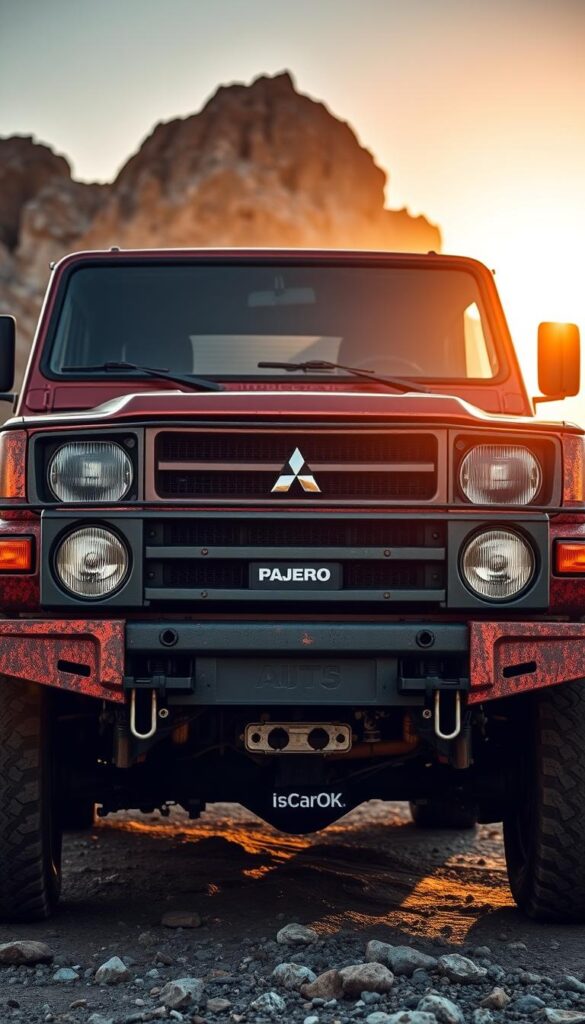
The Pajero’s design has influenced cars long after it was made. Car fans see it as a key moment in off-road history. It raised the bar for how cars should perform and last.
Impact on Off-Road Vehicle Design
Classic SUV fans love the Pajero for its big changes in off-road tech. It brought:
- Advanced four-wheel-drive tech
- Strong chassis design
- Flexible suspension systems
- New ways to build car bodies
Collector’s Value and Market Position
The Pajero’s value shows its amazing history. It’s honored by the Japan Automotive Hall of Fame. Over 3.3 million were sold during its time.
| Model Generation | Collector Desirability | Estimated Value Range |
|---|---|---|
| First Generation (1982-1991) | High | $15,000 – $35,000 |
| Second Generation (1991-1999) | Medium-High | $10,000 – $25,000 |
| Special Rally Editions | Extremely High | $50,000 – $100,000 |
To off-road fans and classic SUV collectors, the Mitsubishi Pajero is more than a car. It shows the power of car innovation and lasting design.
Second Generation Excellence (1991-1999)

The second generation Pajero changed SUV design forever. It brought new technologies that made off-road driving better. From 1991 to 1999, Mitsubishi made a car that raised the bar for SUVs.
One big change was in four-wheel drive technology. The Pajero evolution made it stand out from others in the 1990s. It was a game-changer.
- Introduced Super Select 4WD system
- Implemented Multi-Mode ABS technology
- Added electronic shock absorbers
- Enhanced structural rigidity
The 1990s saw big improvements in SUVs, and the Pajero was at the forefront. It was designed to be great on roads and off them. It could handle city streets and rough trails with ease.
It also got better engines and suspension. The second generation Pajero showed Mitsubishi’s dedication to making better SUVs. It listened to what drivers wanted.
The Pajero wasn’t just an SUV; it was a statement of engineering excellence and adventure.
The second generation Pajero became a top SUV. It set new standards for how SUVs should perform, be comfortable, and versatile.
Super Select 4WD: Game-Changing Technology
The Mitsubishi Pajero changed off-road driving with its Super Select 4WD system. This system made SUVs more versatile and powerful. It gave drivers control on different terrains.

Mitsubishi’s Super Select 4WD changed how drivers handle tough roads. It had four driving modes:
- 2H: Standard two-wheel drive for normal road conditions
- 4H: High-range four-wheel drive for moderate off-road terrain
- 4HLc: High-range four-wheel drive with center differential lock
- 4LLc: Low-range four-wheel drive with center differential lock
System Components and Operation
The Super Select 4WD system is smart because it can switch to 4WD at high speeds. Drivers could adjust their vehicle’s performance easily. This made the Pajero very adaptable for off-road driving.
Off-Road Capabilities and Advantages
The Super Select 4WD was unique because of its flexibility. It worked well on rocky trails and highway roads. The Pajero’s 4×4 systems offered great traction and stability. This made off-road driving easier for everyone.
Camel Trophy Adventures and Achievements

The Camel Trophy was the ultimate test for off-road vehicles, especially the Mitsubishi Pajero. These competitions pushed the Pajero to its limits. It became a symbol of endurance and reliability in the world’s toughest terrains.
Mitsubishi entered long wheelbase, first-generation Pajeros in the Camel Trophy. They showed the Pajero’s amazing off-road skills. The extreme conditions proved the Pajero’s durability and performance.
- Participated in multiple international Camel Trophy events
- Showcased Pajero endurance in grueling terrain
- Developed specialized off-road modifications
Mitsubishi made a special “Camel Trophy Edition” Pajero to celebrate. This model had unique features that highlighted its performance in extreme conditions.
| Camel Trophy Pajero Specifications | Special Features |
|---|---|
| Wheelbase | Long wheelbase configuration |
| Modifications | Enhanced suspension, reinforced chassis |
| Collector Status | Highly sought after by enthusiasts |
The Pajero’s success in the Camel Trophy made it famous. It showed the Pajero could handle any terrain, from forests to mountains.
“The Pajero didn’t just participate in the Camel Trophy – it conquered it.” – Off-Road Enthusiast Magazine
Interior Evolution and Comfort Features
The Mitsubishi Pajero changed from a tough off-road vehicle to a luxury SUV. Its interior shows this big change. As luxury off-roaders grew in popularity, the Pajero updated to meet high comfort and style demands.
![]()
The Pajero’s interior got much better over time. It added features that made it stand out from other utility vehicles. Early models were tough, but later ones were more stylish and had new tech.
Cabin Design Improvements
Important changes in the Pajero’s interior design included:
- Enhanced ergonomic layouts
- Premium material selections
- Improved sound insulation
- Streamlined dashboard configurations
Luxury Appointments Through the Years
Luxury features made the Pajero’s cabin better over time:
- Leather upholstery replacing standard fabric
- Dual-zone climate control systems
- Advanced infotainment interfaces
- Multi-adjustable heated seats
“The Pajero represents the perfect fusion of off-road capability and luxury comfort.” – Automotive Design Magazine
The Mitsubishi Pajero made a big leap by focusing on comfort without losing its off-road prowess. It successfully combined utility with luxury in the SUV market.
Engine Performance and Power Evolution
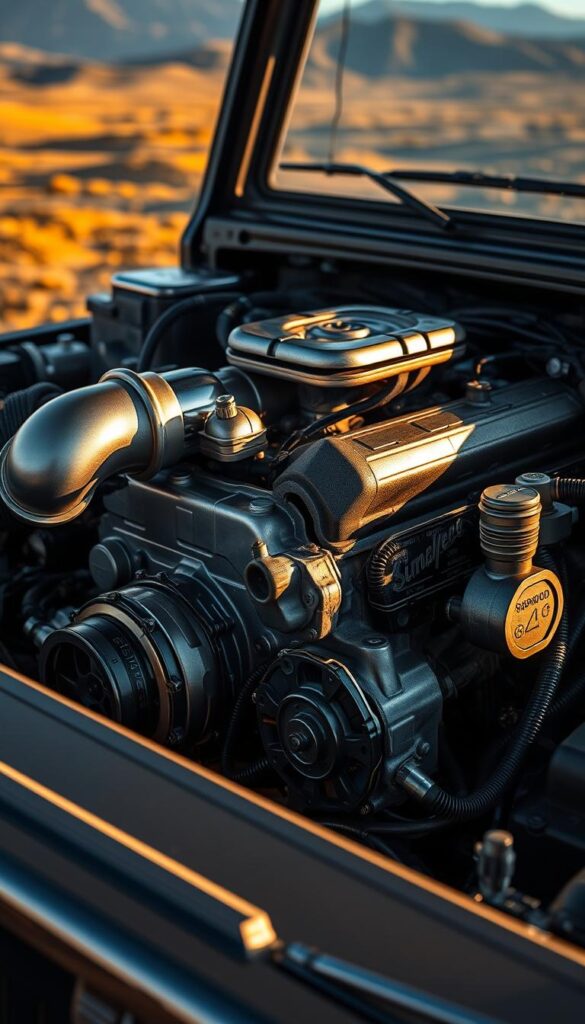
The Mitsubishi Pajero’s engine development is a showcase of engineering skill. It has evolved from its first models to the latest, always improving off-road and on-road performance.
Over the years, the Pajero has had many engine options. Early models had smaller 2.0L engines. Later, more powerful 3.8L engines were introduced, boosting the SUV’s performance.
- First-generation engines focused on basic reliability
- Mid-generation models introduced more sophisticated diesel engine options
- Later generations emphasized fuel efficiency and power output
Diesel fans loved the Pajero’s engines. The diesel versions offered great torque and better fuel economy. This made the SUV great for city driving and off-road adventures.
| Generation | Petrol Engines | Diesel Engines | Performance Characteristics |
|---|---|---|---|
| 1st Generation | 2.0L – 2.6L | 2.3L Diesel | Basic off-road capability |
| 2nd Generation | 2.4L – 3.0L | 2.5L – 2.8L Turbodiesel | Improved power and efficiency |
| 3rd Generation | 3.0L – 3.5L | 3.2L Common Rail Diesel | Advanced performance technologies |
| 4th Generation | 3.5L – 3.8L | 3.2L Advanced Turbodiesel | Peak SUV performance and efficiency |
The Pajero’s engine evolution shows Mitsubishi’s dedication to betterment. Each new generation brought better power, efficiency, and environmental friendliness. This has made the Pajero a top choice in SUVs.
Global Market Impact and Regional Variants
The Mitsubishi Pajero became a global SUV leader, showing its ability to adapt in many markets. Its success came from making regional variants that met local tastes and car needs.

Mitsubishi’s global plan made the Pajero a flexible model with unique identities for each region. The SUV’s name and features changed a lot, showing a smart approach to marketing cars worldwide.
North American Montero: A Distinctive SUV Experience
In North America, the Pajero was called the Montero, appealing to Spanish-speaking buyers. The Montero stood out with:
- Strong V6 engines
- Improved safety features
- Refined inside design
- Bigger size than other variants
Mitsubishi stopped making the Montero in North America in 2006. This ended an era for this SUV in the region.
European Shogun: Conquering British Terrain
In the UK, the Pajero was known as the Shogun, famous for its off-road skills. European buyers loved the Shogun for its:
- Top-notch four-wheel-drive system
- Diesel engine choices
- Compact yet strong design
- Ability to handle tough European roads
The Shogun’s success in the UK showed the Pajero’s global appeal. It also showed Mitsubishi’s skill in making SUVs that fit local tastes.
Safety Innovations and Structural Advances
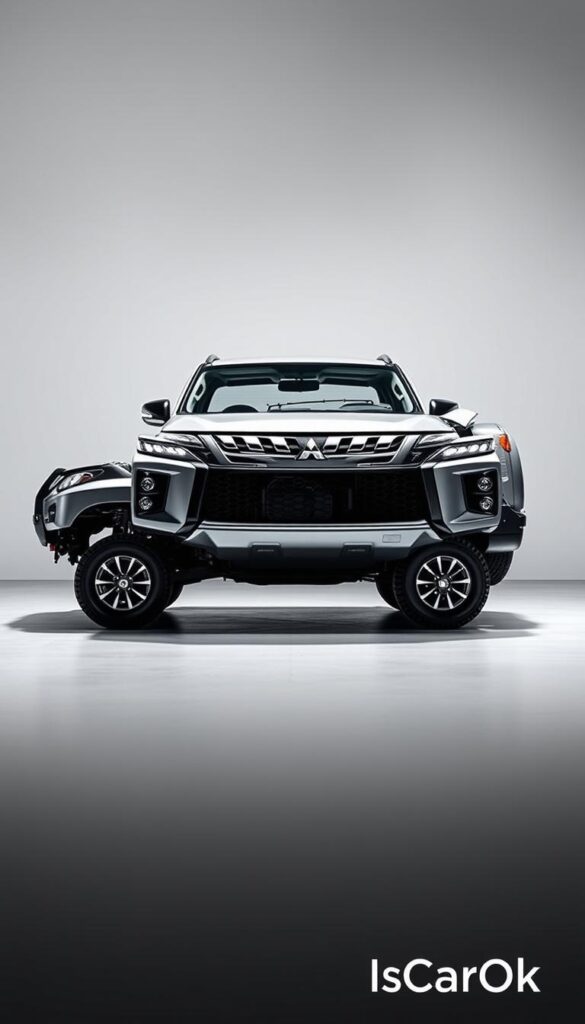
The Mitsubishi Pajero changed the game in SUV safety with new tech. It set high standards for safety in off-road vehicles. Each new model brought big steps forward in design and safety features.
Early Pajero models were tough, but later ones added advanced safety features. Mitsubishi’s team worked hard to make a strong chassis. This could handle tough off-road conditions and keep passengers safe.
- Advanced crumple zones designed to absorb impact energy
- Multi-stage driver and passenger airbag systems
- Electronic stability control for enhanced driving safety
- Anti-lock braking system (ABS) with advanced traction management
The Pajero’s design pushed the limits of safety engineering. Its high ground clearance and tough build needed new safety solutions. Mitsubishi created special structural parts to keep the vehicle safe and off-road ready.
By the late 1990s, the Pajero was a top choice for safety in SUVs. It added advanced electronic safety systems. This made it a great family SUV for both wild adventures and city driving.
“Safety isn’t just about surviving a crash, but preventing one entirely” – Mitsubishi Engineering Team
Your Pajero was more than a car—it showed the power of safety in car design. It still inspires new SUVs today.
Special Editions and Limited Models
The Mitsubishi Pajero is a standout in the SUV world. It has many special editions that have caught the eye of collectors and off-road fans. These special editions show off Mitsubishi’s top engineering and design skills.
The Pajero Evolution is a true treasure among collector Pajeros. It was made in just 2,693 units for racing. Its unique look and features make it stand out from regular Pajeros:
- Widened body with aggressive styling
- Enhanced performance suspension
- Specialized rally-tuned engine
- Unique aerodynamic modifications
Mitsubishi didn’t stop at the Evolution model. They made many special editions for different regions. These became instant hits among collectors:
| Special Edition | Key Features | Production Quantity |
|---|---|---|
| Pajero Metec | Off-road performance package | Limited production |
| Pajero Dakar Edition | Rally-inspired design elements | Extremely rare |
| Pajero Safari | Enhanced expedition capabilities | Regional special release |
These special editions are more than just cars. They are pieces of art that show the Pajero’s legendary status in off-road SUVs. Collectors and fans are always looking for these rare models. This keeps their value high and keeps the Pajero’s rich history alive.
Aftermarket Support and Modification Culture
The Mitsubishi Pajero has become a favorite among off-road fans and modification experts globally. Pajero modifications have turned this classic SUV into a customizable vehicle. It attracts those who love adventure and performance.
Off-road upgrades for the Pajero aim to boost its impressive abilities. SUV tuning experts have created specialized parts. These parts greatly enhance the vehicle’s performance and toughness.
- Suspension lift kits for increased ground clearance
- Heavy-duty bumpers and protective skid plates
- Advanced four-wheel-drive system enhancements
- Performance exhaust and intake systems
- Upgraded shock absorbers and springs
Global aftermarket companies have vast modification catalogs for Pajero owners. These specialists offer everything from small aesthetic changes to full performance upgrades.
| Modification Category | Popular Upgrades | Typical Cost Range |
|---|---|---|
| Suspension | Lift kits, heavy-duty springs | $500 – $2,500 |
| Engine Performance | Turbo upgrades, ECU remapping | $1,000 – $5,000 |
| Exterior Protection | Bull bars, rock sliders | $800 – $3,000 |
Enthusiast communities are key in sharing Pajero modification knowledge. Online forums, social media groups, and websites connect owners. They share tips, show off their builds, and suggest trusted brands.
Whether you want mild off-road tweaks or extreme terrain prep, the Pajero modification scene has it all. Your vehicle can be transformed into a personalized off-road machine. It will reflect your unique style and performance needs.
Conclusion
The Mitsubishi Pajero is a key figure in off-road vehicle history. It changed the SUV design world over 40 years. With over 3.3 million units sold, it changed how people tackle tough terrain and adventures.
This vehicle did more than just move people. It became a symbol of exploration and innovation. You’ve seen how it went beyond just being a car.
The Pajero introduced the Super Select 4WD technology and won the Dakar Rally. It redefined off-road capabilities. Its legacy is not just about its tech, but also its spirit of resilience and engineering.
The Pajero’s end in 2021 was a big loss for car lovers. They loved its reliability and versatility. But, its impact on cars is still felt today.
Even though it’s not made anymore, the Pajero’s influence is still strong. Its design, tech, and racing wins have made it a classic. For those who know true off-road performance, the Mitsubishi Pajero is still the top choice.

